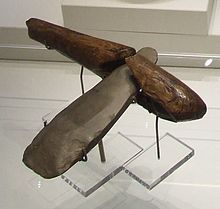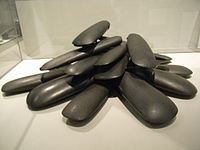Langdale axe industry
54°26′49″N 3°03′50″W / 54.447°N 3.064°W

The Langdale axe industry (or factory) is the name given by archaeologists to a Neolithic centre of specialised stone tool production in the Great Langdale area of the English Lake District.[1] The existence of the site, which dates from around 4,000–3,500 BC,[2] was suggested by chance discoveries in the 1930s. More systematic investigations were undertaken by Clare Fell[3][4][5] and others[6][7][8] in the 1940s and 1950s, since when several field surveys of varying scope have been carried out.[1][9][10][11][12]
Typical finds include reject axes, rough-outs and blades created by
The area has outcrops of fine-grained
Recent research has shown that Langdale tuff was used for tools before the Neolithic 'axe factories' were established. In
Petrographic analysis


Archaeologists are able to identify the unique nature of the Langdale stone by taking sections and examining them using
Polishing the rough surfaces will have improved the
Distribution and use
The stone axes from Langdale have been found at archaeological sites across Britain and Ireland. An unusual concentration of finds occurs in the East of England, particularly Lincolnshire. Francis Pryor[15] attributes this to these axes being particularly valued in this region. He mentions possible religious significance of the axes, perhaps related to the high peaks from which they came. He compares this with confirmed Neolithic flint mines which, apart from Grime's Graves (where flint of exceptionally high quality was mined), were all at prominent elevated locations.
Of all the Neolithic polished stone axes that have been examined in the UK, around 27% come from the Langdale region. This is notable considering there were over 30 sources of material for stone axes from Cornwall to northern Scotland and Ireland.
Whether religious objects or not, the axes must have been of high value, given that they have been "traded" so widely. Some axes appear worn whilst others appear unused, again implying that they were regarded as sacred objects or, perhaps, simply as a display of visible wealth. Some though were used as practical tools. The shape of the polished axes suggests that they were bound in wooden staves and used for forest clearance.
Francis Pryor discusses a flint axe that he found north of Peterborough with fantastic swirling patterns that had been brought out by polishing – but this axe was totally impractical as the patterns were fault lines, making the flint very fragile. However, it must have been valued by its owner and/or maker, bearing in mind the work involved in making it. These facts suggest various interpretations of the purpose of the Langdale axes, which were both beautiful and practical, as well as being traded many miles from their place of production.
Context

The Langdale industry was one of many which extracted hard stone for manufacture into polished axes. The Neolithic period was a time of settlement on the land, and the development of farming on a large scale. Maintenance of the forest cover was necessary in order to plant crops and rear animals, so axes were a staple tool, not just for clearance but also for wood working timber for houses, boats and other structures.


But other hard and tough stones were used, such as
Radiocarbon dating at the Langdale stone axe factory site suggests that it was in operation for about 1,000 years during the Neolithic period.
Current thinking links the manufacturers of the axes to some of the first Neolithic stone circles such as that at Castlerigg.[16][17]
Conservation
The altitude and rough terrain of the archaeological sites have protected them from types of damage caused by human settlement in lowland areas. However, Great Langdale is much visited by walkers. People have removed axes (although current thinking is that they should be left in situ) and have caused inadvertent damage to stone scatters by walking.
An attempt to schedule the sites as ancient monuments in the 1980s was thwarted by the lack of reliable mapping.[18] However, English Heritage has been considering questions on how the sites should be managed.[19] Particular attention has been paid to the siting of footpaths to avoid damage to axeworking sites.[18] Since the 1990s eroded paths in the Lake District, including Great Langdale, have been repaired by a "Fix the Fells" project in which the National Trust is the major partner.
Langdale axes are displayed in Cumbria at Kendal Museum and Tullie House Museum and Art Gallery, Carlisle,[20] and in other collections such as the British Museum.
See also
Notes
References
- ^ S2CID 130925089. (For accompanying material see Supplement 1of same volume).
- S2CID 197554465.
- ISSN 0309-7986 – via Archaeology Data Service.
- ISSN 0309-7986– via Archaeology Data Service.
- S2CID 112636558.
- S2CID 140588391.
- ^ Plint, R. G. (1952). "The Great Langdale Stone Axe Factory" (PDF). Journal of the Fell & Rock Climbing Club of the English Lake District. Vol. 16, no. 2. pp. 121–124.
- ISSN 0309-7986– via Archaeology Data Service.
- ISSN 0309-7986– via Archaeology Data Service.
- ISSN 0589-9036– via Archaeology Data Service.
- ^ Schofield, Peter (2005). Stickle Tarn, Great Langdale, Cumbria (PDF) (Report). Lancaster: Oxford Archaeology North. Issue No. 2005-2006/452 (OAN Job No. L9589).
- ^ Schofield, Peter (2009). Axe Working Sites on Path Renewal Schemes, Central Lake District, Cumbria (PDF) (Report). Lancaster: Oxford Archaeology North. Issue No. 2008-2009/903 (OAN Job No. L10032).
- ISBN 0415058457 – via Internet Archive.
- ISSN 1363-5387.
- ISBN 0007126921.
- ^ "Ancient monuments - The Heritage Journal". wordpress.com. Retrieved 24 October 2015.
- ^ Article on Castlerigg and the axe industry of Langdale
- ^ a b Axeworking sites on path renewal schemes
- ^ "National Importance Programme". english-heritage.org.uk. Retrieved 24 October 2015.
- ^ information about the stone axes that the Tullie House Museum has in its collection
